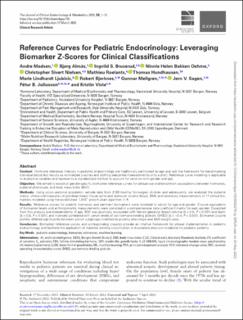| dc.contributor.author | Madsen, Andre | |
| dc.contributor.author | Almås, Bjørg | |
| dc.contributor.author | Bruserud, Ingvild Særvold | |
| dc.contributor.author | Oehme, Ninnie Helen Bakken | |
| dc.contributor.author | Nielsen, Christopher Sivert | |
| dc.contributor.author | Roelants, Mathieu | |
| dc.contributor.author | Hundhausen, Thomas Eckhard | |
| dc.contributor.author | Ljubicic, Marie Lindhardt | |
| dc.contributor.author | Bjerknes, Robert | |
| dc.contributor.author | Mellgren, Gunnar | |
| dc.contributor.author | Sagen, Jørn V. | |
| dc.contributor.author | Juliusson, Pétur Benedikt | |
| dc.contributor.author | Viste, Kristin | |
| dc.date.accessioned | 2022-06-07T12:15:54Z | |
| dc.date.available | 2022-06-07T12:15:54Z | |
| dc.date.created | 2022-05-20T10:30:51Z | |
| dc.date.issued | 2022 | |
| dc.identifier.issn | 0021-972X | |
| dc.identifier.uri | https://hdl.handle.net/11250/2997717 | |
| dc.description.abstract | Context
Hormone reference intervals in pediatric endocrinology are traditionally partitioned by age and lack the framework for benchmarking individual blood test results as normalized z-scores and plotting sequential measurements onto a chart. Reference curve modeling is applicable to endocrine variables and represents a standardized method to account for variation with gender and age.
Objective
We aimed to establish gender-specific biomarker reference curves for clinical use and benchmark associations between hormones, pubertal phenotype, and body mass index (BMI).
Methods
Using cross-sectional population sample data from 2139 healthy Norwegian children and adolescents, we analyzed the pubertal status, ultrasound measures of glandular breast tissue (girls) and testicular volume (boys), BMI, and laboratory measurements of 17 clinical biomarkers modeled using the established “LMS” growth chart algorithm in R.
Results
Reference curves for puberty hormones and pertinent biomarkers were modeled to adjust for age and gender. Z-score equivalents of biomarker levels and anthropometric measurements were compiled in a comprehensive beta coefficient matrix for each gender. Excerpted from this analysis and independently of age, BMI was positively associated with female glandular breast volume (β = 0.5, P < 0.001) and leptin (β = 0.6, P < 0.001), and inversely correlated with serum levels of sex hormone-binding globulin (SHBG) (β = −0.4, P < 0.001). Biomarker z-score profiles differed significantly between cohort subgroups stratified by puberty phenotype and BMI weight class.
Conclusion
Biomarker reference curves and corresponding z-scores provide an intuitive framework for clinical implementation in pediatric endocrinology and facilitate the application of machine learning classification and covariate precision medicine for pediatric patients. | en_US |
| dc.language.iso | eng | en_US |
| dc.publisher | Oxford University Press | en_US |
| dc.rights | Attribution-NonCommercial-NoDerivatives 4.0 Internasjonal | * |
| dc.rights.uri | http://creativecommons.org/licenses/by-nc-nd/4.0/deed.no | * |
| dc.title | Reference curves for pediatric endocrinology: leveraging biomarker z-scores for clinical classifications | en_US |
| dc.title.alternative | Reference curves for pediatric endocrinology: leveraging biomarker z-scores for clinical classifications | en_US |
| dc.type | Journal article | en_US |
| dc.type | Peer reviewed | en_US |
| dc.description.version | publishedVersion | en_US |
| dc.rights.holder | Copyright The Author(s) 2022 | en_US |
| dc.source.articlenumber | dgac155 | en_US |
| cristin.ispublished | true | |
| cristin.fulltext | original | |
| cristin.qualitycode | 2 | |
| dc.identifier.doi | 10.1210/clinem/dgac155 | |
| dc.identifier.cristin | 2025889 | |
| dc.source.journal | Journal of Clinical Endocrinology and Metabolism (JCEM) | en_US |
| dc.identifier.citation | Journal of Clinical Endocrinology and Metabolism. 2022, dgac155. | en_US |

